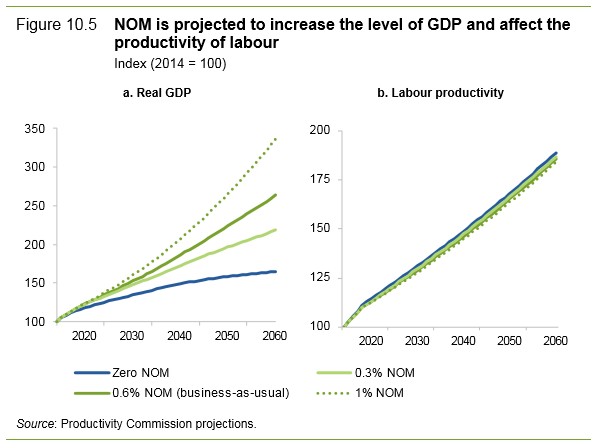Slowly but surely the pillars supporting Australia’s high immigration program are collapsing, with The Australian’s Judith Sloan the latest to call for Australia’s immigration intake to be significantly wound-back:
High levels of immigration are obviously associated with a bigger economy. But the assessment of the economic benefits of immigration must be made in per capita terms and it is here that the estimated economic gains are in fact very small and are highly dependent on the model used.
The Productivity Commission thinks gross domestic product could be 7 per cent higher in 45 years because of our immigration program.
But let’s be clear, this is a tiny gain across a very long period. Moreover, no account is taken of the impact of immigration on congestion, environmental pressures or housing affordability.
…the annual (permanent) immigration program [of 190,000 excluding humanitarian entrants] is too high and has been for some time…
The reality is that the setting of the permanent migrant intake numbers is partly driven to suit the higher education sector. Selling courses and the potential for permanent residence in Australia is a much more attractive package than selling courses alone…
The Productivity Commission has already belled the cat on the astronomical cost of the contributory parent visa. For a sum just under $50,000 each, the parents of migrants are able to enter the country and, after a period, are fully entitled to every benefit available to those born in Australia, including the Age Pension.
The real cost to the Australian taxpayer is between $335,000 and $420,000 per visa holder. In net present value terms, this amounts to between $2.6 billion and $3.2bn for every annual intake of migrant parents. If Morrison were really serious about budget repair, he would be doing something about this scheme…
The bottom line is this: self-praise for our immigration program by the government is no recommendation. The number of planned permanent immigrants is too high and has been for some time — it should be scaled back immediately to closer to 100,000 a year. The list of occupations in short supply also needs to be reviewed, again with some serious scaling back required…
And as for the proposed temporary parent visa category, just don’t do it. We can’t afford it, it will cause resentment and it’s just bad policy.
Spot on. Since 2003, when John Howard first opened the immigration flood gates, Australia’s population has grown by a whopping 22% – way faster than other advanced English-speaking nations and 2.5 times the OECD average:
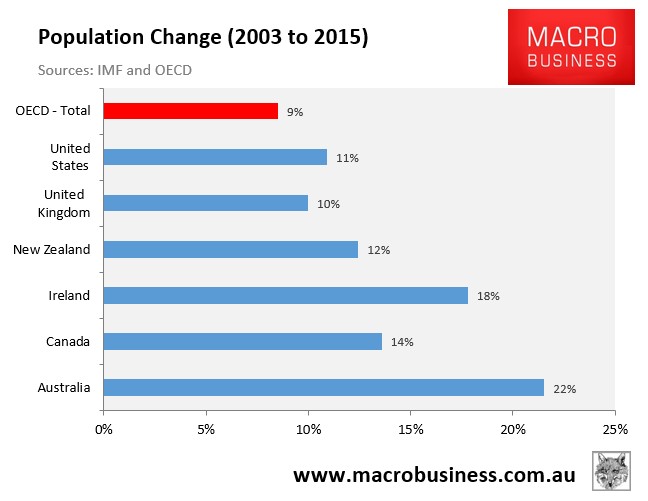
Moreover, this unprecedented growth is projected to continue for decades to come on the back of high immigration:
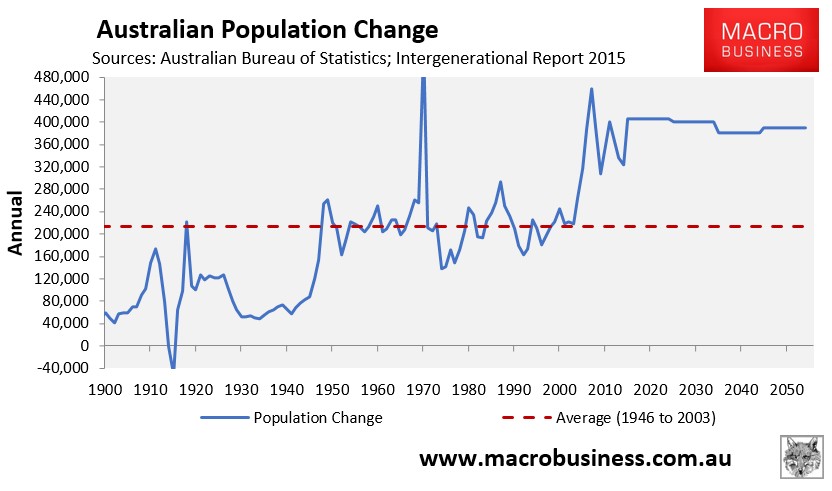
The effects of this immigration deluge have been felt clearly across our major cities where traffic congestion has worsened significantly and housing has become increasingly unaffordable.
While the Productivity Commission’s (PC) latest modelling on immigration did find that current settings would boost per capita GDP by 2060 versus zero net overseas migration, these findings need to be taken with a huge pinch of salt.
All of the modelled benefits are transitory since they come from improving Australia’s population pyramid as younger immigrants lower the average age profile of the population and increase the ratio of working aged to non-working aged (called a ‘demographic dividend’). However, as the migrants grow old they too will add to the number of retired people, thus requiring ever more immigration and an ever bigger population to keep the age profile stable (classic Ponzi Demography). To quote the PC:
The continuation of an immigration system oriented towards younger working-age people can boost the proportion of the population in the workforce and, thereby, provide a ‘demographic dividend’ to the Australian economy. However, this demographic dividend comes with a larger population and over time permanent immigrants will themselves age and add to the proportion of the population aged over 65 years.
Labour productivity is also modelled to decrease under current immigration settings, as are real wages, versus a zero NOM baseline:
Compared to the business-as-usual case, labour productivity is projected to be higher under the hypothetical zero NOM case — by around 2 per cent by 2060 (figure 10.5, panel b). The higher labour productivity is reflected in higher real wage receipts by the workforce in the zero NOM case.
Therefore, the PC’s latest modelling shows a situation whereby ongoing high immigration improves per capita GDP by 2060 by boosting the proportion of workers in the economy, but this comes at the expense of lower labour productivity and lower real wages. Moreover, the benefits on workforce participation would only be transitory, with the migrants themselves aging and dragging on growth after the forecast period.
Importantly, the PC cautioned that the modelled higher real GDP per person does not capture the negative externalities from immigration – such as greater congestion, reduced housing affordability, and environmental degradation – nor does it account for any distributional impacts.
On the last point, the PC’s prior modelling on the economic impacts of skilled migration, conducted in 2006, found that all of the benefits flow to the immigrants themselves, whereas existing Australian residents’ incomes are lowered through immigration – hardly a ringing endorsement.
Another thing Sloan could have mentioned is that since the immigration flood gates were jammed open in 2003, Australia’s per capita GDP and disposable income has grown at an anaemic rate compared to the previous corresponding 12-year periods (see below charts).
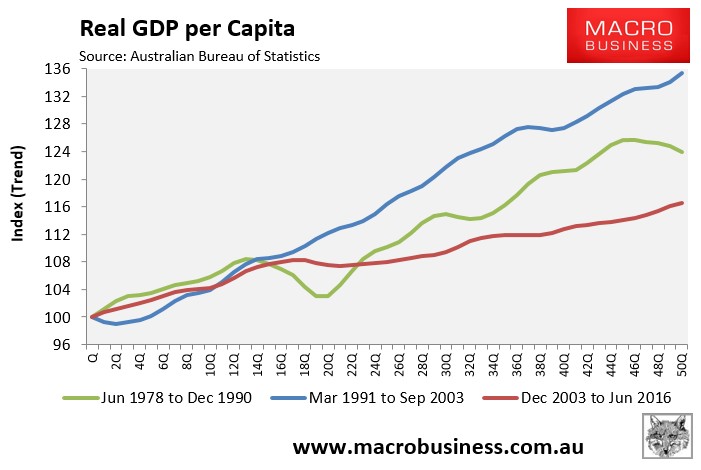
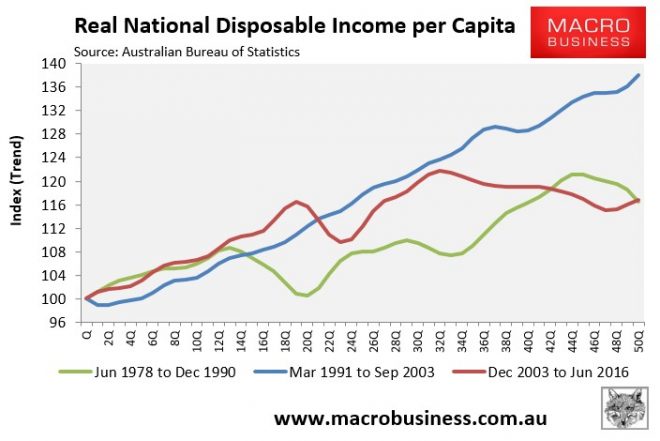
And this comes despite growth in the terms-of-trade being most favourable across the most recent 12-year period (see next chart).
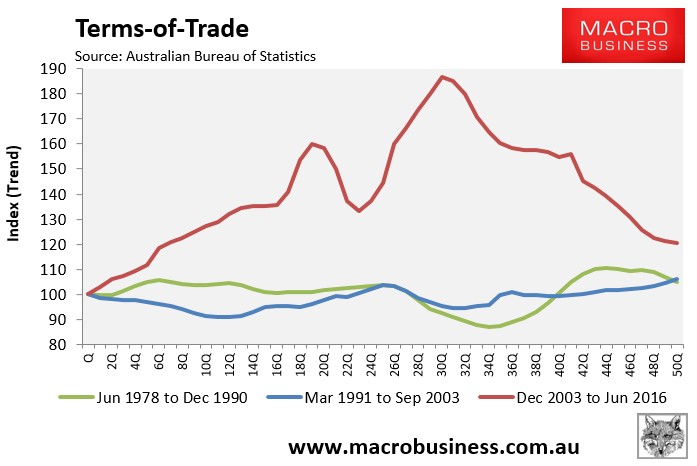
When viewed alongside qualitative measures like traffic congestion and housing affordability, which have clearly worsened as the population has exploded, there is a strong case to be made that Australia’s high population growth strategy has very likely lowered individual living standards.
International evidence also does not support Australia’s high immigration program.
The next chart plots the change in per capita real GDP against population over the years 2000 to 2015 across the 35 OECD member nations (Australia is shown in red):
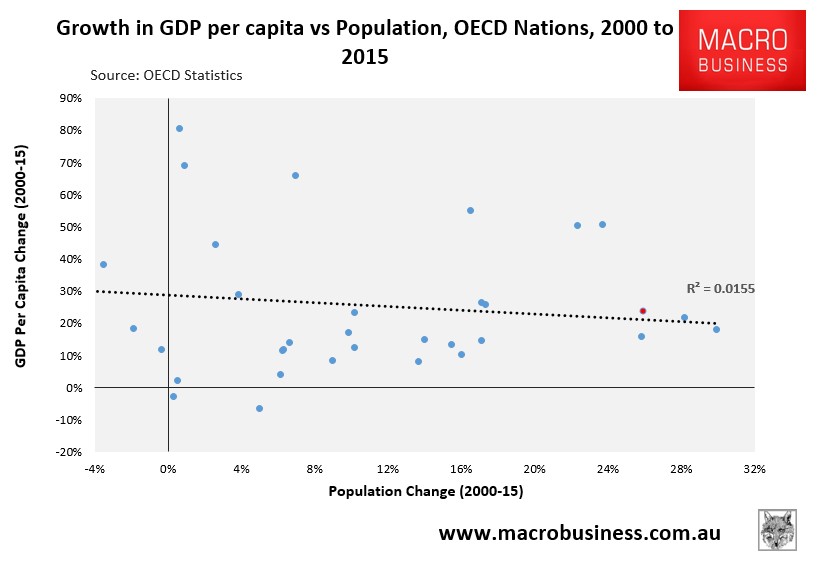
As you can see, there is no statistically significant relationship between the growth in the population and per capita real GDP across OECD member nations.
The next chart shows the relationship between population growth and labour productivity growth across the 35 OECD member nations over the period 2000 to 2015 (Australia shown in red), and again shows no statistically significant relationship:
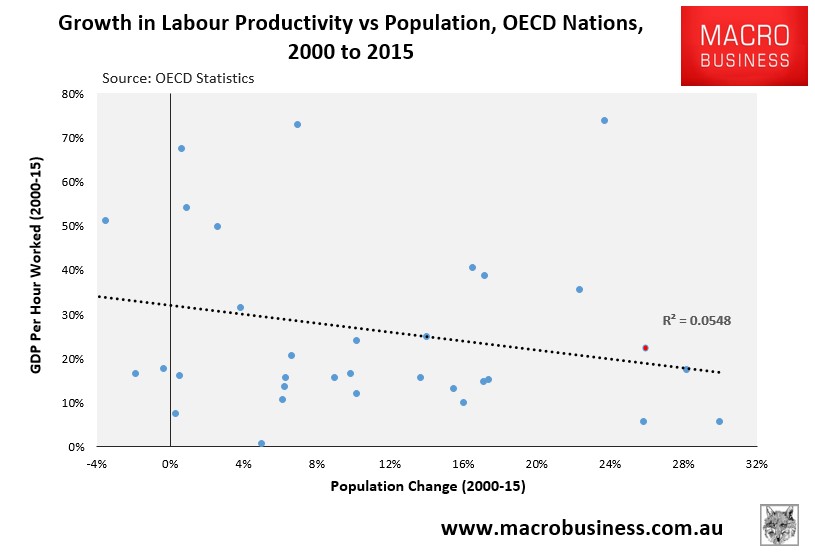
The relationship between population growth and multifactor productivity growth, which is plotted below across 20 OECD member nations (where data is available) over the period 2000 to 2014 (Australia shown in red) also shows no statistically significant relationship:
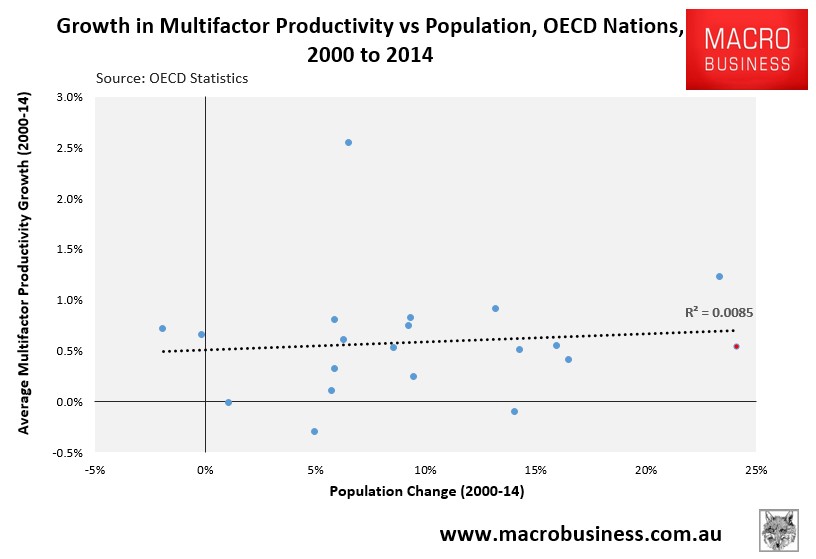
Despite experiencing some of the highest population growth in the OECD, Australia’s productivity growth has been lackluster by comparison. While this does not by itself suggest that Australia’s high immigration program has lowered productivity, it is nigh impossible to argue that it has raised it either.
In summary, the broad macroeconomic data – both domestic and international – does not support the assertion that Australia needs to run a high immigration program in order to drive the economy and increase living standards. In fact, given the considerable qualitative costs – for example, the degradation of the environment, the depreciation of natural resources and decline in individuals’ quality of life – there is significant cause to dial Australia’s immigration program right back.

